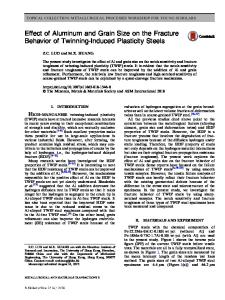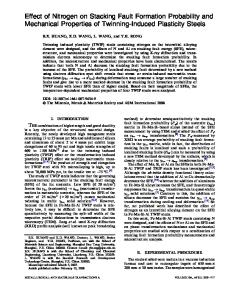Effect of Stress States on Twinning Behavior in Twinning-Induced Plasticity Steel
- PDF / 4,351,999 Bytes
- 15 Pages / 593.972 x 792 pts Page_size
- 111 Downloads / 498 Views
JMEPEG https://doi.org/10.1007/s11665-019-04254-1
Effect of Stress States on Twinning Behavior in TwinningInduced Plasticity Steel Joong-Ki Hwang (Submitted January 12, 2019; in revised form April 25, 2019) The effects of stress state on the twin structures and kinetics in twinning-induced plasticity (TWIP) steel have been investigated to understand the twinning behaviors in more detail. Twinning behaviors of tension, compression, wire drawing, and caliber rolling were evaluated and compared using the EBSD technique, TEM measurement, and Schmid factor analysis. Twin structures, such as twin thickness, twin variant, twin shape, and twin kinetics were different with stress states. The specimen under compressive stress had wavyshaped twins, less twin variant, lower twin thickness, and more twin volume fraction in comparison with the specimen under tensile stress. The different structures and kinetics of deformation twin with stress state were highly related to the grain rotation during plastic deformation. Under tensile stress, the grain rotation to orientation, twinning-favored regions by Schmid factor analysis, encouraged the lateral growth of twins, more twin variants, and straight-type twins, while the grain rotation to orientation under compressive stress suppressed the twin growth and twin variant and developed wavy-shaped twins. Drawn wire and caliber-rolled wire had both twin features under tensile and compressive stress states and higher twin volume fraction since complex stress state that combined tension and compression was applied in these processes. The hardness values were strongly related to the twin volume fraction with strain and stress state. Keywords
deformation twin, grain rotation, stress state, twinning-induced plasticity (TWIP) steel
1. Introduction Improving the fuel efficiency of vehicle and the safety of passenger is a big trend in iron and steel making industry for automotive applications. The steels thus need to possess high strength to decrease the overall car weight and good formability to form complex parts by plastic forming process. However, simultaneously improving the strength and formability of metals remains a challenge. Consequently, this contradictory requirement has led to search for new high-performance materials. High strain hardening rate has been observed in some face-centered cubic (FCC) alloys with low stacking fault energy (SFE) such as austenitic stainless steels, transformationinduced plasticity (TRIP) steels, and twinning-induced plasticity (TWIP) steels. Among them, TWIP steels have received considerable attentions over the past few decades due to the excellent combination of strength and ductility combined with outstanding energy absorption capacity stemming from their high strain hardening rate (Ref 1-6). The high strain hardening rate of TWIP steel can be classically explained by dynamic strain aging (DSA) and socalled dynamic Hall–Petch effect. DSA is attributed to the pinning of mobile dislocations by the small solute atoms diffusing within the matrix (Ref 6-9)
Data Loading...











